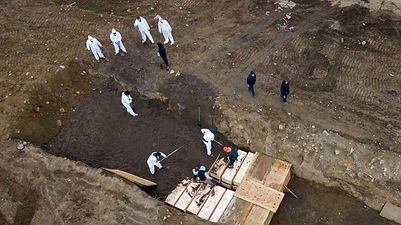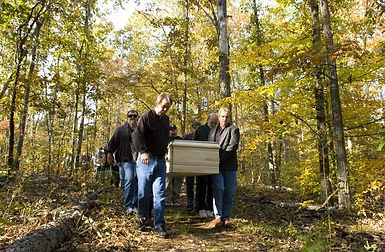
Discover New York: Waterworld
Daniel Polishchuk
My e-Portfolio
Hart Island in the 21st Century
For 150 years, Hart Island, an island located east of the Bronx, has been used to bury New York City’s unclaimed or unidentified dead in mass graves. Most of the city was unaware that they had died, or even lived, and barely anyone is concerned when they die (Ferretti). Nevertheless, these are people that can eventually be identified by someone. Therefore, anyone but especially families who have close personal ties to a descendent, family members, close friends, and partners, should have unrestricted access to the island. Just like family members who have access to their loved one’s graves at other cemeteries that are open to everyone all day, family members of those buried at Hart Island should have the opportunity to spend time at the final resting place of their loved ones and be able to honor and pay their respects. How long it took to “claim” them should not matter at all. Currently, relatives must reserve visits to the island and can only access it by a ferry that rarely runs. It should become operated as if it were a “park”. For example, open to the public during the day, with a ferry that runs every half an hour. Hart Island is already one of the largest tax-funded cemeteries, but additional funds could come from the Department of Transportation. As of 2017, their budget for transit operations was close to one hundred million dollars (NYC Office of Management and Budget). I think that the ferry to Hart Island should be included within that, as it is an extremely important and meaningful project. Creating a park would also open up several job opportunities to people who would properly maintain the island and park, the way a resting place for many should be treated. This is especially important during the COVID-19 pandemic, and far more beneficial than having inmates from Rikers Island work on the island. Many people can’t afford a private burial or funeral director, and opening the park to everyone will ensure a safe place to bury their loved ones within New York City. Additionally, many people have specific burial practices based on their religion and their customs. Under the Department of Corrections, they have no control over how the burial takes place. If Hart Island is turned into a park and more access is allowed, more people have the opportunity to do funerals the way they choose to with the assistance of an office that supports people in need of burial assistance which should be established on the island. Improved access to Hart Island will undoubtedly have endless benefits and create more awareness among inhabitants of New York City of how burials of the poor and marginalized were handled for 150 years by the same institution that runs our jails and prisons.
However, improved access to the island can bring many issues as well. The island could have many difficulties as allowing more people to access an island where more than one million people have been buried, can overwhelm it unless efficient transportation methods are made. Many people’s loved ones are already buried on the island and improving access would only encourage more people to visit the island and perform burials on what is an already relatively small island. This could open up the danger of reaching the island’s capacity far quicker, and eventually bring up the question of what to do with thousands of other unclaimed or unidentified bodies. This is especially important now with the COVID-19 pandemic. During the first few months of the outbreak in New York City, the burial rate in Hart Island increased tremendously. Additionally, it is questionable how much funds the city would choose to invest in that type of project. City agencies have forced families to resign themselves to never seeing their loved ones again, and concrete changes have only been pushed under the guidance of Melinda Hunt, the founder of “The Hart Island Project” (Blau). Furthermore, the constituents of City Island are concerned that their community could become overwhelmed, as they do not have the infrastructure to support a ferry service from City Island to the burial ground, and linking the two islands would create a “public safety hazard” (Splvack). The island is also vulnerable to climate change, something that the city is not able to easily control all-year-round, or generally in the future. Soil erosion from storms have exposed remains, and bones have washed up on shores. The Department of Corrections has limited access to the island because of these dangerous conditions, security concerns regarding the inmate laborers, and the absence of any amenities or utilities (Kilgannon). For these reasons and many others, it has been a difficult process to turn the operation of Hart Island over to the Department of Parks and Recreation. Unless the island is completely transformed, it has too many dangerous conditions for the public to be able to access it daily.
I think the Island must be transferred over to the Department of Parks and Recreations. A site such as this should have no connection to the Department of Correction. Since they operate it and use inmates as gravediggers, access becomes restricted. Law enforcement has more important jobs relative to their position to do than oversee Hart Island. Transfering Hart Island over to the parks department allows for the Island to be preserved and make it feel more like a peaceful resting place than a restrictive area. This allows for families to have burials based on their belief on how it should be done. Many lawsuits have argued that the city’s policy that restricts gravesite visits violated constitutional rights to exercise one’s religion (Blau). Under current conditions, cases of unclaimed bodies being lost or used for other purposes without consideration of religious or personal wishes continue to occur. As a Jew, there are specific traditions and customs that we follow for a funeral and burial. First, it should take place within one day following the date of death which is followed by 7 days of mourning. Exceptions can be made for the family that can’t immediately be present or for other practical reasons. The body is seen as extremely holy, so there is a ritual cleansing process where the body is cleaned and groomed in preparation for the funeral. In the process, family members can also participate in placing dirt on the coffin. If Hart Island were to take control of a burial with customs such as this, the family’s rights would be completely violated. Having inmates place the bodies in a pine box that is marked by a black marker is not a dignified burial. Proper burials help express a family’s beliefs, thoughts, and feelings about the death of someone loved. The process helps acknowledge the reality of death, and express grief in a way consistent with the culture’s values. For this reason, the transformation of Hart Island is so important. The family has the right to part with their loved ones in a way that makes them comfortable, and not have it be in the control of people who are strangers to them.
A green burial is an environmentally friendly burial, in which the body is buried in a manner that has the least impact on the environment. The casket is made from biodegradable, non-toxic, and sustainable materials. No screws, nails, or other types of metal hardware are used. The purpose of a green burial is to have rapid decomposition and to return the body’s nutrients into the soil. Any casket made of materials such as wood, woven materials, or cardboard are all environmentally friendly alternatives. The design proposals of James Carroll offer some very interesting ideas and have many benefits. Green burials can increase the capacity of the island for continuing burials. Additionally, if bodies are buried in mounds and planted over, this reduces the risk of erosion and the effect of a rising sea level. The mounds itself provide for future ecological and social use, allowing people to have more access around the island. By moving to green burials, more people may become attracted to doing private burials, which can help cover the economic costs of transportation to the island and general maintenance of the park. They are also far less cheap than a traditional funeral. Over time, the accumulation of burial mounds will attract more visitors to Hart Island, as they can create monumental landscapes with some incredible views of New York City (Carroll). Another alternative form is the option of “becoming a tree”. You can plant someone’s cremated remains, and it transforms a person's loved one into a new form of life. There are special incubators that help take care of the tree by watering it, monitoring the soil, and reporting back on the plant’s growth. Using methods such as these would make Hart Island the city's only "natural" or "green" burial place, allowing bodies to decay quickly into the earth, perhaps with trees over them, and memorializing them online through GPS, rather than markers. The city might even be able to sell such graves to affluent, ecology-minded New Yorkers if it addresses the shore erosion that has at times sent skulls to wash ashore on City Island (Bernstein). To conclude, natural burials emphasize environmental sustainability. In an age where climate change is becoming a prevalent issue, green burials are an extremely beneficial method for the environment and reducing our carbon footprint in addition to practical reasons such as costs or increasing the capacity of cemeteries.
Works Cited
Bernstein, Nina. "Officials Criticize Proposal to Turn Potter's Field Over to Parks Dept.: [Metropolitan Desk]." New York Times,
Jan 21, 2016. ProQuest, https://jerome.stjohns.edu/login?url=https://www-proquest-
com.jerome.stjohns.edu/docview/1758303817?accountid=14068.
Blau, Reuven, and Stephen R. Brown. "GRAVE DECISION City Making Kin Visits to Potter's Field Easier." New York Daily News, Jul 08, 2015, pp. 23. ProQuest, https://jerome.stjohns.edu/login?url=https://www-proquest-
com.jerome.stjohns.edu/docview/1694722646?accountid=14068.
By, FRED F. "About New York: Last Ride to Harts Island." New York Times (1923-Current file), Aug 14, 1974, pp. 30. ProQuest,
https://jerome.stjohns.edu/login?url=https://www-proquest-com.jerome.stjohns.edu/docview/120053681?
accountid=14068.
James Carroll. Necropolis, New York: Envisioning the Future of Hart Island, 2016.
Kilgannon, Corey. "City, in Settlement, Will Let Relatives Visit Grave Sites at Potter's Field: [Metropolitan Desk]." New York
Times, Jul 09, 2015. ProQuest, https://jerome.stjohns.edu/login?url=https://www-proquest-
com.jerome.stjohns.edu/docview/1694906226?accountid=14068.
Martin, Kristen. “Abolishing the Prison of the Dead: Kristen Martin.” The Baffler, 2 Jan. 2020, thebaffler.com/salvos/abolishing-
the-prison-of-the-dead-martin?utm_campaign=Hart+Island
Spivack, Caroline. “Hart Island Will Become Publicly Accessible Parkland.” Curbed NY, Curbed NY, 14 Nov. 2019,
ny.curbed.com/2019/11/14/20963508/hart-island-new-york-public-parkland.




.jpg)


Aerial view of Hart Island.
Soil erosion on shores of Hart Island.
Inmates working on Hart Island during the COVID-19 pandemic.
Markers showing where mass graves are.